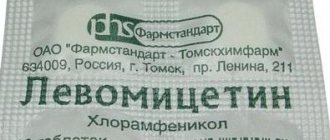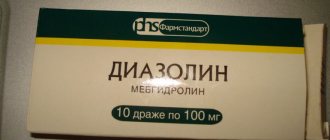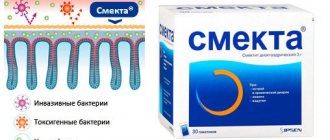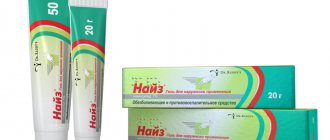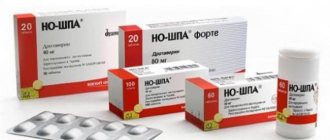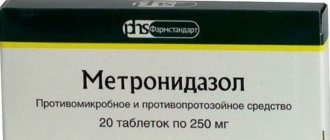In spring and summer, when grasses and trees bloom, there is a peak in allergic diseases, respectively, in hypersensitive people, the issue of choosing antihistamines becomes relevant. The variety of drugs from this group greatly complicates the correct choice. Claritin instructions for use, which comes with the kit, is one of the few drugs that allows you to solve the problem of allergies comprehensively, without affecting only individual symptoms.
Many may ask which is better: Claritin or Suprastin, Erius or Claritin, Zyrtec or Claritin, because these medications have also proven themselves quite well in the treatment of allergic reactions. It will be difficult to give an unambiguous answer, because each drug is prescribed based on the individual characteristics of the patient’s body. There are a number of people for whom the choice of Zodak or Claritin, for example, is obvious, because these medications have different compositions, and the patient may be allergic to some of the components of the drug. Having the same principle of action and therapeutic effect, all of the above drugs are different, and only a qualified doctor can choose the optimal one, depending on concomitant diseases and the severity of the allergy.
Release form and composition
Currently, the drug is produced in the form of two versions - syrup and tablets.
The tablets have a characteristic white color and do not contain impurities. A distinctive feature is the presence of a trademark and engraving of the manufacturer on one side of the medicine. The main active ingredient is Loratadine (10 mg), the role of auxiliary components necessary to maintain the form and improve absorption are:
- lactose monohydrate – 0.0813;
- starch made from corn – 0.008;
- Magnesium stearate – 0.007.
Claritin is packaged in blisters containing 10 tablets. Branded cardboard packaging may contain 1 (10 tablets) or 3 (30 tablets) such blisters.
Claritin syrup is a yellowish liquid, transparent consistency, without sediment. Available in the form of bottles made of dark glass, which is necessary for additional protection from the sun. Volume – 60 or 120 ml. Each bottle is packaged in a cardboard box, which additionally contains a spoon and a syringe (they are used to dose the medicine).
The concentration of the active substance is 1 mg/ml. Additional components for each ml of solution are as follows:
| Substance | Concentration, mg/ml |
| Glycerol | 0,1 |
| Propylene glycol | 0,1 |
| Lemon acid | 0,0096 |
| Sodium benzoate | 0,001 |
| Sucrose | 0,6 |
| Artificial flavor | 0,0025 |
| Purified drinking water | up to 1 ml |
Claritin
It can also be taken as a prophylactic agent to prevent relapses of those chronic diseases whose pathogenesis is based on allergic inflammation (bronchial asthma and the like). The drug belongs to the group of antihistamines: it selectively blocks histamine receptors.
Composition and release form
Claritin is available in oval-shaped tablets in blisters of 7, 10 or 15 pieces (1-3 blisters) in a cardboard package. Detailed instructions are included with the drug.
The tablets contain the active ingredient loratadine. Excipients: lactose monohydrate, magnesium stearate, corn starch.
Clinical and pharmacological group: histamine H1 receptor blocker. Antiallergic drug.
What does Claritin help with?
Indications for the use of Claritin are:
- Skin pathologies of allergic origin.
- Idiopathic urticaria (in particular, chronic).
- Year-round and seasonal allergic conjunctivitis and rhinitis (to eliminate the symptoms associated with these pathologies - rhinorrhea, itching of the nasal mucosa, sneezing, lacrimation, itching and burning sensation in the eyes).
pharmachologic effect
The long-term and rapid antiallergic effect of Claritin is due to the properties of the active component - loratadine, which is a blocker of peripheral histamine H1 receptors.
An improvement in the condition is observed half an hour after taking Claritin, the maximum antihistamine effect occurs after 8-12 hours.
When used against the background of allergic conjunctivitis, year-round and seasonal allergic rhinitis, Claritin helps eliminate the symptoms caused by these diseases - itching of the nasal mucosa, sneezing, rhinorrhea, lacrimation, itching and burning sensation in the eyes.
pharmachologic effect
Claritin has antiallergic and antipruritic effects.
The effect of the drug is ensured by blocking H1-histamine receptors located in the peripheral parts of the nervous system. As a result, the production of the most significant inflammatory mediator, histamine, is reduced, which is responsible for the formation of edema, the appearance of spasm of smooth muscles of blood vessels and internal organs, and hypersecretion of mucus during the development of allergic and autoimmune reactions in the human body.
A distinctive feature of the drug is that it does not penetrate the blood-brain barrier and does not affect the central parts of the nervous system. Consequently, Claritin does not cause drowsiness and does not contribute to pathologies of psychomotor reactions (attention, assimilation of information, etc.).
After taking the drug, active absorption begins. After just 0.5 hours, a clear therapeutic effect occurs; after 90 minutes, the maximum antihistamine effect occurs, which lasts from 12 to 24 hours (depending on the individual characteristics of the body, the functional state of the liver and kidneys).
The drug is eliminated primarily through the kidneys (40%) and gastrointestinal tract (42%) within 10 days or more after the last dose. In case of severe damage to the urinary system or liver, the dosage should be changed, since Claritin remains in the body for a longer period. This may cause an overdose.
Analogues of Claritin
Level 4 ATX code matches:
- Clarisens
- Histaphene
- Loratek
- Telfast
- Claridol
- Erius
- Loratadine
- Fexadine
- Fexofast
- Peritol
- Desloratadine
- LauraHEXAL
- Clarotadine
- Rupafin
- Ciel
- Dramamine
- Lordestin
- Lomilan
- Fenkarol
- Kestin
Cheaper analogs of Claritin are very popular: Loratadine, Lomilan. Claridol and Clarotadine. Also have a similar effect: Erius. Lotharen, Clalergin, Clarisens. Clarifarm, Clarifer, Clarfast, Loragexal. Alerpriv, Clargotil and Erolin. The price of analogues varies between 20-350 rubles.
Claritin or Erius - which is better?
The question that often comes up online is, which of these drugs is better? Each of them is a new generation antiallergic antihistamine. Therefore, they are characterized by almost the same strength of therapeutic action and a minimum of side effects. However, it is believed that Erius has a broader spectrum of action, since it is active in eliminating allergic cough.
However, you can come across many reviews when patients report that the drug Erius does not help them and they started taking Claritin or vice versa. Thus, the question of choosing a drug depends on the individual characteristics of each person.
Indications for use
Pathologies for which this drug should be used are:
- Occurring seasonally or year-round, allergic rhinitis is an inflammation of the nasal mucosa of an allergic nature, caused by exposure to various allergens (from flower dust to house mites). Typical symptoms are: persistent nasal congestion, itching, sneezing. Less commonly observed is a disorder of taste and smell, congestion in the ears with distortion of sound perception.
- Allergic conjunctivitis is an inflammatory lesion of the conjunctiva of both eyes with a massive set of symptoms: lacrimation, swelling of the eyelids and periorbital tissue, fear of bright light sources. In severe cases, swelling of the eyeball may develop with temporary partial loss of vision, narrowing of the fields of perception, etc.
- Chronic idiopathic urticaria is an allergic dermatosis that has many causative factors and a long course (over 6 months). The clinical picture manifests itself in the form of unbearable itching and rash, represented by densely located papules from 2 to 3 mm in diameter, rising above the surface of the skin. Blisters with a diameter of 0.1 to 5 cm, filled with transparent exudate, may also occur. They can merge and burst, exposing massive eroded surfaces of the skin, prone to infection by bacterial agents. Over time, many cosmetic defects and functional disorders of the central nervous system (for example, insomnia) develop.
- Skin itching of various etiologies. It can be observed during a large number of allergopathologies and autoimmune processes. Liver diseases, accompanied by impaired bilirubin metabolism and deposition of its crystals in the dermis, also have this unpleasant subjective symptom.
- Allergic reactions caused by insect bites (wasps, mosquitoes).
Claritin indications
Claritin belongs to the group of antiallergic drugs, providing antipruritic and antihistamine effects. The main indications for its use are:
- year-round allergic rhinitis and hay fever (seasonal allergic rhinitis);
- pseudo-allergic reactions associated with the consumption of histamine liberators (chocolate, tomatoes, coffee, strawberries, cocoa and other allergenic products)
- year-round and/or seasonal allergic conjunctivitis;
- acute and idiopathic chronic urticaria;
- diseases of the skin and soft tissues of an allergic nature (eczema, dermatitis);
- angioedema (tongue, larynx and pharynx);
- allergic reactions to insect bites;
- complex therapy of bronchial asthma.
At the same time, this medicine relieves the main symptoms of these pathological conditions - itching, rashes, sneezing, runny nose, swelling of the mucous membranes, lacrimation, bronchospasm and burning sensation.
Contraindications
The range of conditions for which the use of Claritin is prohibited includes:
- Age less than 2 years (for syrup) and less than 3 years (when using tablet forms).
- Impaired tolerance to galactose and lactase (when using tablets, as they contain lactose).
- Deficiency of sucrase or isomaltase in the body against the background of rare hereditary pathologies (prohibited when taking syrup due to its sucrase content).
- Individual high sensitivity to various components of this product.
In case of severe kidney and liver diseases, the dosage of the drug should be changed depending on the degree of decrease in the functional activity of the organs. Before starting to take the medication, you must consult a doctor and undergo a full examination.
Indications and contraindications
The antihistamine Claritin is effective in combating the manifestations of seasonal and chronic allergic diseases. It is also often used to prevent the occurrence of allergic reactions and in cases where prompt blocking of histamine endings is required.
Indications for use of the drug:
- seasonal allergies that contribute to the appearance of rhinitis, conjunctivitis, hay fever (pollen intolerance);
- urticaria in chronic and acute form (we recommend reading: how is acute urticaria in children treated?);
- prolonged allergic runny nose;
- allergies after insect bites;
- the appearance of edema of various origins (including Quincke's edema);
- damage to the skin of allergic origin (eczema, dermatitis, etc.);
- pseudo-allergic reactions provoked by the consumption of histamine liberators (strawberries, citrus fruits, tomatoes, cocoa, chocolate).
Taking Claritin can quickly eliminate various inflammatory allergy symptoms:
- nasal congestion;
- swelling of the nasal mucosa and skin;
- itching;
- sneezing;
- burning;
- skin rashes (blisters, ulcers, rash);
- runny nose;
- tearfulness;
- conjunctivitis;
- bronchospasm.
Claritin is not recommended for children under 2 years of age. There are also absolute contraindications:
- individual intolerance or hypersensitivity to some components of the drug;
- lack of lactose in the patient's body.
Use during pregnancy and lactation
Using the drug while breastfeeding is strictly prohibited, as it passes into breast milk and enters the baby’s body. The dose can be not just toxic, but also lethal. You can start breastfeeding only 10 days after you stop taking the medication.
Claritin also crosses the placental barrier and can adversely affect the embryonic development of the fetus. A number of large clinical trials have proven that the teratogenic and mutagenic effects of the drug are realized only in the first 12 weeks of pregnancy (first trimester), after which the drug can be used, but with caution.
special instructions
It is highly not recommended to use the medicine during lactation. The substance loratadine penetrates into milk very easily. Here it reaches approximately the same concentration as in Therefore, if there is a need to use the drug Claritin, you should stop feeding the baby for this period.
The product is widely in demand in pediatrics. For children from two years of age, it is allowed to use only syrup. Children over three years of age can use the tablet form.
Alcohol does not affect the effect of the drug. However, it can cause side effects. In this regard, it is recommended to refrain from drinking alcohol during treatment.
Can drivers use this drug? Unlike first-generation drugs (such as Diazolin, Diphenhydramine, Tavegil), Claritin does not cause a pronounced slowdown in reactions and drowsiness in patients. Therefore, the medicine is not contraindicated for use by drivers. However, you should be extremely careful. Since the above-mentioned drug still has such an adverse reaction as drowsiness.
Directions for use and doses
Dosage features depend on the form of the drug. For tablets:
| Adults and children over 12 years old | 1 tablet (10 mg) 1 time per day |
| Children from 6 to 12 years old whose body weight exceeds 30 kg | 1 tablet 1 time per day |
For persons under 6 years of age or with a body weight less than 30 kg, the drug is prescribed only in the form of syrup.
For the syrup:
| Children from 3 to 12 years old weighing more than 30 kg | 2 measuring spoons (10 ml) once daily |
| Persons under 12 years of age weighing less than 30 kg | 1 scoop (1 ml) 1 time per day |
The medication can be used regardless of meals and at any time of the day. Contact with food slows down the absorption process, which prolongs the time before the onset of the therapeutic effect.
The safety and effectiveness of Claritin in children under 2 years of age has not been proven, since clinical trial data are completely absent. It is not advisable to prescribe the drug to persons aged 3 years due to the high incidence of adverse reactions (3-5%).
The maximum duration of treatment for adults and children over 12 years old is 30 days, from 3 to 12 years old – 14 days.
Claritin or Zyrtec
Claritin and Zyrtec are antihistamines of different generations. To understand the essence of the problem, consider generations of antiallergic antihistamines:
- 1st generation
- drugs Tavegil, Suprastin, Fenistil and Diphenhydramine; - 2nd generation
– the drug Zyrtec; - 3rd generation
– drugs Claritin, Telfast, Erius.
The first generation of drugs has an excellent antiallergic effect, which is combined with a strong side effect in the form of drowsiness. The second generation of antihistamines (Zyrtec) has a significantly smaller drowsiness effect, but also has a weaker antiallergic effect compared to the first generation drugs. But the third generation (Claritin, Telfast, Erius) has a pronounced antiallergic effect, like the first generation, combined with an almost complete absence of side effects in the form of drowsiness. Based on the above, the effectiveness of Claritin is higher and the side effects are less than that of Zyrtec.
Due to this circumstance, Claritin should be preferred over Zyrtec. However, the drugs contain different active substances, so the effectiveness of their effects also depends on the individual qualities of the body. Often in practice there are situations when Zyrtec helps one person perfectly, and Claritin is completely useless, or exactly the opposite. In view of this state of affairs, if you do not have experience in using anti-allergy drugs, then first choose Claritin and try taking it, but if it turns out to be ineffective, switch to Zyrtec. More information about Zyrtec
Side effects
The list of pathological reactions is extensive. These include:
- Headache (2.7%). It is often diffuse in nature.
- Dizziness (less than 0.01%).
- Increased neuropsychic excitability, nervousness (2.8%).
- Decreased tolerance to physical activity, fatigue (less than 1%).
- Sleep disorders (insomnia).
- Increased drowsiness (observed within 3-5 hours from the moment of taking the medication).
- Increased appetite (0.5%).
- Dyspeptic disorders (vomiting and nausea, bloating, stool disorders such as diarrhea).
- Exacerbation of chronic diseases of the gastrointestinal tract (gastritis, pancreatitis, peptic ulcer of the stomach and duodenum).
- Liver dysfunction caused by increased necrosis of hepatocytes (clinically manifested by increased levels of transaminases - ALT and AST, less often - impaired bilirubin metabolism).
- Disorders of the cardiovascular system (increased heart rate, palpitations in the left half of the chest, in 1 case out of 100,000 there is an increase in blood pressure with the development of crises in people suffering from hypertension). Non-sinus arrhythmias may occur.
- Alopecia (about 0.02% of cases). Baldness is typical for the skin of the trunk and limbs. There were no cases of hair loss from the scalp.
- Anaphylactic shock is a rapid generalized dilation of large arteries due to relaxation of the muscles of the middle layer of the vascular wall. The condition is accompanied by a drop in blood pressure with disruption of the trophism of all organs and tissues. There is pallor of the skin with a marble tint, cyanosis of the distal limbs and nasolabial triangle, depression of consciousness up to coma.
- Skin rash of any kind.
If disorders of the digestive tract develop, it is recommended to stop using the medication. Impaired liver function with an increase in AST and ALT by less than 2 times is a relative contraindication for use, higher is an absolute contraindication.
For mild headaches, no help is required; for severe headaches, stop taking Claritin. For relief, non-steroidal anti-inflammatory analgesics (Nurofen) are used.
The development of anaphylactic shock is a reason to urgently call a team of doctors and begin emergency care:
- Rinse your mouth and nasal cavity with running water (particles of the drug may remain there) and drip 1-2 drops of a 1% solution of adrenaline hydrochloride. In its absence, you can use any drops for a runny nose or for the treatment of angle-closure glaucoma, since they contain adrenomimetic substances (Xylene, Galazolin, Rhino-stop).
- Rinse the stomach. In the absence of special systems, you should drink 1-2 liters of liquid and reflexively induce vomiting. Then you need to take activated carbon. Dosage – 1 tablet for every 10 kg. person's weight.
- Place the patient on the right side. In this case, the lower half of the body should be located above the head end. You also need to extend the lower jaw and watch out for the retraction of the tongue, which can lead to asphyxia.
- Ensure maximum flow of fresh air (open all windows and doors). The fan does not help increase the amount of oxygen taken into the body. The feeling of cooling is associated with increased evaporation of moisture from the surface of the skin.
- Increase chest excursion. To do this, it is recommended to undress the patient to the waist or unbutton his outer clothing.
- Ensure warming of the body by placing heating pads with warm water under the upper and lower extremities.
The patient will be urgently hospitalized in the intensive care unit or intensive care unit.
If tachycardia develops, the action plan can be presented as follows:
- Call an emergency medical team.
- Make the patient sit (a chair or bed with pillows placed under the back and head).
- Ensure maximum flow of fresh air.
- Make it easier for the patient to breathe by unfastening or removing clothing from the upper half of the body.
- Take any sedative available in the house (for example, Afobazol or Corvalol).
- If the heart rate increases above 120, it is recommended to massage the eyeballs, which can lead to a reflex slowdown in heart rate. Use your index finger and thumb to press on the lateral surfaces of each eyeball for 5-15 seconds.
- Wipe your face with a cloth soaked in cold water.
- Try to make rare but deep breathing movements.
A set of such measures allows in some cases to stabilize the patient’s condition. With the development of severe rhythm disturbances (ventricular or atrial fibrillation, extrasystole), minutes count. Therefore, before providing assistance to the victim, it is imperative to call a team of doctors.
If tachyarrhythmia causes loss of consciousness, then the patient is placed on his side, the airway lumen is cleared as much as possible (the lower jaw extends and the tongue protrudes).
Side effects when taking Claritin
The instructions state the following list of possible side effects:
- Nausea;
- Liver dysfunction;
- Attacks of gastritis;
- Cardiopalmus;
- Headache;
- Fast fatiguability;
- Dry mouth;
- Sedation disorder;
- Anaphylaxis;
- Skin rash;
- Alopecia.
The manufacturer notes that the likelihood of side effects is less than 2%.
Manufacturer
The production and sale of Claritin is carried out by the Belgian corporation Scherhing-Plough Lobo NV, which is a subsidiary of Merck & Co. Inc.
The manufacturer is famous for creating high-quality medical products in many areas and independently conducting independent clinical trials. He has many awards received during participation in international competitions.
The main production facilities are located in the United States of America and a number of European countries. There is one plant in Russia.
Price
- Claritin tablets, price – 227 rubles;
- Claritin syrup, price – 250 rubles.
The pricing policy for the drug depends on the number of tablets in the package. There are packs of 10 and 30 pieces. Relatively inexpensive, for salvation from hated allergies. Which drug from those offered to choose is entirely your decision.
All antihistamines have a similar effect, but differ in side effects and mechanism of influence on the body.
Analogs
Claritin has many analogues with a similar active ingredient (Loratadine). Some representatives are described below. The list of contraindications, side effects and indications is identical. The method of administration and dosage are similar to Claritin, assuming that 1 tablet contains 10 mg of the active substance, and the concentration of the active ingredient in the syrup is 1 mg per ml.
| Name of the drug | Release form | average price |
| Lomilan | Tablets 10 mg (each pack contains 7 or 10 pieces). Also available in syrup form, 5 ml. | Tablets (10 pcs.) – 100 rubles. Syrup – 110 rubles. |
| Loratadin-Teva | Tablets 10 mg. Each package contains 7, 10 or 30 pieces. | Blister of 7 tablets – 140 rubles, 10 pieces – 180 rubles, 30 tablets – from 280 rubles. |
| Erolyn | Tablets 10 mg. (1 blister contains 5 or 10 pieces). Syrup – 120 ml. | 5 tablets – 200 rubles, 10 – 350 rubles. The cost of syrup is from 300 rubles. |
| Alerpriv | Tablets 10 mg. Each carton contains 10 or 30 tablets. It is also available in containers of 100 or 1000 tablets each. | 10 tablets – 150 rubles, 30 tablets – 330 rubles. |
| Clargothyl | Tablets (10 mg), 10 pieces in each pack. | 180 rubles. |
Side effects
Claritin has a small number of side effects that differ in adults and children.
Claritin on the domestic pharmaceutical market has not only analogues, but also synonyms. Synonyms are drugs that also contain loratadine as an active ingredient. And analogues are drugs that have the same therapeutic effects as Claritin, but contain another substance as an active ingredient.
So, the following drugs are synonymous with Claritin:
- Alerpriv tablets;
- Clallergin tablets;
- Clarifer tablets;
- LoraHexal tablets;
- Loratadine Stada tablets;
- Loratadine-Verte tablets;
- Loratadine-Teva tablets;
- Loratadine-OBL tablets;
- Tablets, lozenges and suspension Lomilan;
- Clargotil syrup and tablets;
- Claridol syrup and tablets;
- Clarisens syrup and tablets;
- Clarotadine syrup and tablets;
- Loratadine syrup and tablets;
- Syrup and tablets Loratadine-Hemofarm;
- Erolin syrup and tablets;
- Rectal suppositories Lotharen.
Analogues of Claritin include the following drugs:
- Allerfex tablets;
- Histafen tablets;
- Gifast tablets;
- Diacin tablets;
- Dimebon tablets;
- Dimedroquine tablets;
- Dinox tablets;
- Dramamine tablets;
- Ketotifen-Ros tablets;
- Lordestin tablets;
- Ciel tablets;
- Telfast tablets;
- Fexadin tablets;
- Fexo tablets;
- Fexofast tablets;
- Desloratadine-Teva tablets;
- Beksist-sanovel tablets;
- Rupafin tablets;
- Fexofenadine tablets;
- Tablets Desloratadine Canon;
- Diazolin tablets with zinc sulfate;
- Dragees and Diazolin tablets;
- Dimedroquine solution, administered subcutaneously and intramuscularly;
- Kestin syrup and tablets;
- Ketotifen syrup and tablets;
- Syrup and tablets Ketotifen Sopharma;
- Peritol syrup and tablets;
- Erius syrup and tablets;
- Rapido capsules;
- Semprex capsules.
Reviews
My daughter constantly suffers from conjunctivitis. Every year, when the poplar begins to actively bloom, it is simply unrecognizable. Snot, tears. We tried many different remedies. We were allergic to suprastin and broke out in a rash. I recently started giving her Claritin. Surprisingly, the effect is long-lasting; she has the opportunity to feel like a human being. Marina, 38 years old
This amazing story happened to us on a hike. In the evening we baked a lot of pancakes, ate them and left them open in the tent. Apparently the sweets attracted insects from neighboring areas. In the morning I hear my son screaming loudly, I see a huge red lantern on his right eye. It turns out that he was bitten by a wasp right on the eyelid. It was very swollen, the child was crying. Luckily, my friend had Claritin in her purse. 2 hours after taking it, the swelling noticeably decreased, by the evening there was nothing left except a red spot. I don’t know how other antiallergic drugs behave, but I definitely recommend Claritin to everyone! Gennady, 45 years old
I have suffered from allergies my entire adult life. Every spring turns into a real hell with eternally swollen eyes and incessant tearing. Having tried many drugs, I chose Claritin and have been using it for several years. With him, I was finally able to calmly walk around the city, enjoying nature and flowering plants, and stopped being scared of cats and dogs. I recommend to everyone! Irina, 30 years old
Thus, Claritin is an effective remedy used for the symptomatic treatment of many allergopathologies. Before use, you must carefully study the list of indications, contraindications and dosage regimens for people of different age groups in order to avoid side effects.
Overdose
If an overdose of the drug occurs, the following symptoms will appear:
- It will make you sleepy;
- The heart will beat faster;
- A headache will appear;
- The body will get tired faster.
Treatment of overdose consists of eliminating the symptoms that appear. It is recommended to lavage the stomach to remove the drug before it has time to be absorbed, then take activated charcoal. After such simple manipulations, continue to monitor the child’s condition.
Moms and dads, be sure to remember that it is better to give small children, from 2 to 3 years old, syrup rather than tablets!
Features and shelf life
It is recommended to store the medication out of reach of children at a temperature not exceeding 25 °C. The shelf life of the medicine in tablet form is four years from the date of manufacture, the shelf life of syrup is three years. After the expiration date, the medication cannot be used and must be disposed of in accordance with sanitary standards.
Store tablets at a temperature not exceeding 25 degrees out of the reach of children. The shelf life of the medicine in this form of release is 4 years. After this period, the medicine cannot be taken orally.
Store at temperatures up to 25 °C. Keep away from children.
Shelf life: tablets – 4 years, syrup – 3 years.
Claritin syrup instructions for use
Pharmacokinetics
Loratadine is rapidly absorbed and metabolized in the gastrointestinal tract. The plasma half-life of loratadine is 1 hour, and that of its active metabolite is 2 hours.
The half-life of loratadine averages 8.4 hours (ranges from 3 to 20 hours) and that of desloratadine averages 28 hours (ranges from 8.8 to 92 hours).
The area under the concentration-time curve (AUC) of metabolites is higher than the AUC of loratadine itself.
- Loratadine has a higher affinity for plasma proteins (97%–99%) compared to its active metabolites (73%–76%).
- Excreted in urine (about 40%) and feces (about 42%) within 10 days, mainly in the form of conjugated metabolites.
- A clinical study found that the pharmacokinetic profile of loratadine and its metabolites was comparable in young and elderly volunteers.
The maximum plasma concentration (Cmax) and AUC of loratadine and its metabolites are increased in patients with chronic renal failure compared to healthy patients.
In such patients, the half-life of loratadine and its metabolites differed slightly from healthy patients.
Hemodialysis had no effect on the pharmacokinetics of loratadine and its active metabolite.
- The pharmacokinetics of a single dose of 2.5 mg of loratadine in children aged 1-2 years are comparable to the pharmacokinetics in adult patients and children over 2 years of age.
- Pharmacodynamics
- Loratadine is the active component of the drug Claritin, it belongs to tricyclic antihistamines and is a selective blocker of peripheral H1-histamine receptors.
- In most patients, Claritin does not exhibit anticholinergic or sedative effects when used in recommended doses.
- During long-term treatment, no clinically significant changes in vital signs, laboratory tests, physical examination, or ECG were observed.
Loratadine does not have pronounced activity at H2 receptors. The drug does not inhibit the uptake of norepinephrine and has little or no effect on the cardiovascular system or cardiac pacemaker activity.
The antiallergic effect develops within the first 1–3 hours after taking the drug, reaches a maximum within 8–12 hours and lasts 24 hours. There was no development of drug resistance after 28 days of loratadine use.
Can I take it at the same time?
Antihistamines generally have similar indications for use.
These include:
- atopic dermatitis;
- bronchial asthma;
- seasonal allergies;
- skin and mucous membranes;
- swelling of tissues caused by a hyperimmune reaction of the body;
- increased lacrimation;
- colds;
- hay fever;
- insect bites, etc.
It is recommended to take medications in case of short-term exacerbations of allergies or their chronic course. They are also used to relieve severe inflammatory processes.
Despite the fact that both medications are used in complex treatment, it makes no sense to prescribe them simultaneously. The mechanism of their action is duplicated, adding nothing to the therapy.
Differences
The drugs are derivatives of the same active substance and have similar pharmacological characteristics, but there are differences between Claritin and Loratadine.
Loratadine is a highly effective antiallergic drug, second generation, produced in Russia. Available from pharmacies without a prescription and at a low price - from 20 rubles.
Claritin is an analogue of Loratadine, has an identical composition to it, but belongs to the third generation of drugs, is produced by a well-known foreign pharmaceutical company and the price of the drug is several times higher than the analogue.
But it is worth noting that the therapeutic effect of Claritin occurs faster . Already, after half an hour, the patient begins to feel relief, and the effect continues for more than a day. It has also been noted that Claritin is less likely to cause complications.
However, reviews from those patients who used the medications are mixed. For some, Loratadine provided effective help and they see no point in using the more expensive Claritin. For others, the cheap analogue did not have a therapeutic effect, and they abandoned it and exchanged it for a more expensive remedy.
From the above it is clear that there is no point in taking Claritin together with Loratadine, these are complete chemical equivalents and they act on the body almost identically.
Interaction with other drugs
According to the instructions, Claritin may cause side effects:
- From the nervous system: nervousness (in children), drowsiness, headache, insomnia; very rarely - fatigue, dizziness;
- From the cardiovascular system: very rarely - tachycardia, palpitations;
- From the digestive system: increased appetite (in adults); very rarely - gastrointestinal disorders (nausea, gastritis), dry mouth, liver dysfunction;
- From the skin: very rarely - alopecia;
- Allergic reactions: very rarely - anaphylaxis, rash.
When used simultaneously, the effect of Claritin does not enhance the effect of alcohol on the nervous system.
When Claritin is combined with erythromycin, ketoconazole or cimetidine, a slight increase in the plasma concentration of loratadine occurs, but it has no clinical consequences, including electrocardiographic data.
The instructions warn about the possibility of developing the following side effects when prescribing Claritin tablets:
- From the digestive system in adults: possible – dry mouth, nausea, gastritis; rarely - liver dysfunction.
- From the side of the central nervous system in adults: possible – headache, increased fatigue, drowsiness; in children (rarely) – headache, nervousness, sedation.
- Allergic reactions in adults: possible skin rash; rarely - anaphylactic reactions.
- Dermatological reactions in adults: There have been rare reports of alopecia.
The effect of ethanol on the central nervous system does not increase while taking Claritin.
If simultaneous use with other medications is necessary, it is recommended to consult a doctor to avoid the development of negative side effects and changes in the therapeutic effect.
Composition and effect of the drug
The main active substance in Claritin is loratadine. It blocks the action of histamine.
Histamine is a hormone that is released into the bloodstream when a child comes into contact with an allergen and causes a response from the body - usually in the form of a rash, itching and swelling.
Laratadine reduces the permeability of small vessels and capillaries and, as a result, prevents the listed manifestations of allergies, and also eliminates sneezing, nasal discharge, lacrimation, and burning in the eyes.
Loratadine belongs to the second generation of antihistamines. It is completely absorbed in the digestive tract within 30 minutes after administration, and acts for 24 hours, so you only need to take Claritin once a day. It does not affect the child’s nervous system, behavior and psycho-emotional state, and is not addictive. The child's physical and mental activity does not suffer while taking the medicine.
Review from Ivan Alekseevich, a pediatrician with 20 years of experience from Moscow:
“Claritin is one of the few antiallergic drugs that I prescribe to my patients. Its advantage is a minimum of side effects and is well tolerated by children. An important aspect is the lack of influence on the immature nervous system of children. This is the main argument when choosing Claritin for allergy treatment.”
Children tolerate the drug well.
Therapeutic effect
The composition of Claritin works in several directions at once: it has an antihistamine, antiallergic and antipruritic effect. Such effects are directly related to blocking histamine receptors. The drug begins to act literally within half an hour. The duration of the therapeutic effect is 24 hours, regardless of whether syrup or tablets are used.
The nature of allergies and the human body’s reaction to something foreign is due to histamine. This is a special substance produced by cells upon contact with an allergen. When histamine binds to the appropriate receptors, a chain of reactions is started. They are the ones who lead to allergies. Under the influence of histamine, blood flow increases, the skin and mucous membranes become inflamed, severe itching and a number of other symptoms begin (runny nose, sneezing, coughing, watery eyes).
Thanks to Claritin, histamine receptors are blocked, which helps prevent the development of the reaction. Thanks to this blockage, histamine simply cannot be produced, and therefore there are no symptoms. Even if symptoms have already appeared, after the receptors are blocked, all discomfort quickly passes because there is no support at the cellular level.
Claritin is not able to pass through the blood-brain barrier, or bind to those histamine receptors that are located in the central nervous system. In this regard, the medicine does not have a sedative effect (it is expressed in drowsiness). The product acts selectively, selecting receptors responsible for the development of allergies. This is one of the differences between Claritin and drugs of the previous generation (Diphenhydramine, Suprastin) - they provoke drowsiness in patients.
Who is the drug contraindicated for?
Claritin is prohibited:
- children under two years of age;
- persons with hypersensitivity to the substances included in its composition;
- during lactation.
It is worth noting that this medicine is excreted together with the mother’s breast milk. For this reason, breastfeeding should be stopped during lactation. Claritin is prescribed with extreme caution for liver failure throughout the entire period of pregnancy. If it is necessary to undergo treatment during pregnancy, it is resorted to only if the expected benefit for the expectant mother will significantly exceed the potential threat to her fetus.
Claritin: antiallergic drug
Patient reviews
Irina, 31 years old, Samara: “After returning from the south, my daughter developed a rash. I got scared and immediately called the pediatrician. He noticed that the child was itching. He sent her for tests and the results showed an allergy to fruits; she ate a lot of them. The pediatrician advised me to take Claritin or Loratadine. We chose Claritin. Within a week it was all gone.”
Svetlana, 25 years old, Yaroslavl: “We were just exhausted with the child. At any moment he could sneeze, runny nose, and watery eyes. When the bird cherry blossomed, we simply didn’t know what to do. It was impossible to take me to kindergarten. The pediatrician recommended Claritin or Loratadine. We didn't care, the main thing was that there was syrup. Loratadine turned out to be cheaper, so they chose it. Now, at the slightest ailment, we immediately take it. Everything goes by quickly.”
Leonid, 27 years old, Arkhangelsk: “I have been allergic since childhood. I’m already used to itching all the time, redness and flaking on my body. In spring, your eyes water and your nose itches. He took a variety of medications with varying success. After them, I often felt sleepy or found it difficult to concentrate. But recently a dermatologist prescribed Claritin. He said that I should try the cheaper Loratadine. Now I have it at my fingertips all the time.”
Price
In pharmacies, Claritin is sold at a cost ranging from 155 to 515 rubles. for a pack of tablets. The syrup is sold for 217-247 rubles.
Loratadine in tablet form is much cheaper for patients. One pack costs approximately 10-51 rubles. A bottle of syrup sells for 90-167 rubles.
Claritin and Loratadine are drugs with similar indications and a similar mechanism of action. They are used in adult and pediatric practice. The specialist prescribes one of two drugs of the patient’s choice.
Operating principle
The action of Claritin is antiallergic, antihistamine and antipruritic. It blocks histamine receptors. You can feel the effect of its use within half an hour, and it reaches its maximum after 8-12 hours and lasts for about a day.
When irritating substances (allergens) enter the body, a protective immune reaction is triggered. The release of histamine mediator begins from the cells. It stimulates blood flow, expanding capillaries, which causes an allergic reaction on the mucous membranes and skin. Nasal congestion, eye hyperemia, lacrimation, nasal mucus, itching, urticaria and other characteristic signs of allergies occur. The drug Claritin, by blocking receptors, stops allergic reactions, and existing symptoms are quickly eliminated due to the fact that their support at the cellular level ceases.
The drug is unable to cross the blood-brain barrier and form a connection with histamine receptors located in the central nervous system. Therefore, a sedative effect does not occur, as happens when taking medications of the previous generation. This effect is called selective, since the receptors are located in different tissues, but Claritin only affects those that provoke negative symptoms.
Claritin - first aid for allergies
Claritin tablets and syrup are the result of many years of work by American scientists at Schering Plow. They presented their development to the world more than 20 years ago, and during this period of time the drug received extremely high reviews from both patients and doctors. Of course, it has analogues, the price of some of them is lower, but alternative drugs do not always fully compensate for the patient’s needs.
The action of the drug is based on the ability to block histamine receptors. When coming into contact with an allergen, the cells of the human body try to reject the detected foreign body and produce a special biogenic substance for this - histamine. And Claritin and analogues with the same active ingredient act as antihistamines - H1 receptor blockers. Earlier versions of antiallergy drugs also neutralized H1 receptors, but simultaneously affected other nerve endings, causing drowsiness, lethargy, and sometimes complete disability. To relieve allergic symptoms, they had to be taken several times a day.
Active scientific research has contributed to the emergence of a new generation of antihistamines, which include Claritin. They have a number of advantages:
- for sustainable relief of the condition, tablets or syrup are enough to be taken once a day;
- modern drugs are not able to overcome hematoencephalic protection, therefore they do not have a sedative effect unless the recommended dose is exceeded;
- when taking such antihistamines, other types of receptors are not affected;
- Claritin and its analogues begin to act in a matter of minutes, bringing long-awaited relief to a person and reliably neutralizing H1 receptors.
The effectiveness of Claritin is ensured by the active ingredient loratadine, which is another unique development by specialists from the American company Schering Plow. Analogues of the drug are also based on loratadine, but with different additional components. Reviews from allergists and patients who have used tablets or syrup indicate the positive effect of the drug in eliminating typical allergic symptoms: skin rashes and itching, swelling of the mucous membranes and extremities. It also has a membrane-stabilizing effect and prevents bronchospasm from developing.
The effect of the drug begins a maximum of 25-35 minutes after oral administration, the duration of the antihistamine effect is at least 24 hours.
Dosage form
Claritin's current release form is tablets and medicinal syrup, also called children's Claritin, since it can be used in the treatment of allergies in children without causing the usual difficulties when swallowing. Syrup is a transparent homogeneous solution, which normally does not contain any foreign impurities or sediments, and does not require preliminary shaking before use. The tablets are made in an oval shape, with a specific designation (a cup or flask with the number 10 in the middle, which makes it possible to distinguish the drug from others of a similar type. There is a mark on the reverse side, which allows, if necessary, dividing the tablet in half.
Pharmacological properties
Claritin is characterized by antiallergic, antihistamine and antipruritic properties.
Pharmacodynamics
Loratadine is a tricyclic compound with a pronounced antihistamine effect and is a selective blocker of peripheral H1-histamine receptors. The antiallergic effect occurs soon after administration and lasts quite a long time. Loratadine begins to act within 30 minutes after oral administration of the drug. The peak phase of the antihistamine effect is observed 8–12 hours after the onset of the drug’s action and lasts more than 1 day.
Loratadine does not cross the blood-brain barrier and does not affect the functioning of the central nervous system (CNS). During its administration, no sedative or anticholinergic effects of clinical significance were detected, therefore the drug does not provoke drowsiness and does not reduce the speed of psychomotor reactions when used in therapeutic doses. Taking Claritin does not cause prolongation of the QT interval on the ECG.
Long-term therapy was not associated with changes in vital signs, electrocardiography, laboratory data, or physical examination findings of clinical significance. Loratadine is not characterized by significant selectivity towards H2-histamine receptors.
Pharmacokinetics
Loratadine is well and rapidly absorbed into the gastrointestinal tract. Its maximum concentration in blood plasma is determined 1–1.5 hours after administration, and the maximum concentration of its pharmacologically active metabolite desloratadine is determined after 1.5–3.7 hours. When taking Claritin with food, the time to reach the maximum concentration of loratadine and its metabolite increases by approximately 1 hour, but the bioavailability of the drug does not change. The maximum level of loratadine and desloratadine in the blood does not depend on food intake.
In patients with chronic renal dysfunction, the area under the concentration-time curve (AUC) and the maximum concentration of loratadine and its main metabolite are increased compared to patients with normal renal function. However, the half-lives of loratadine and desloratadine are identical to those in healthy patients.
Loratadine is highly bound to plasma proteins (97–99%), while its metabolite exhibits moderate binding (73–76%).
During metabolism, loratadine is converted to desloratadine using the cytochrome P450 3A4 system and, to a lesser extent, the cytochrome P450 2D6 system. Its excretion occurs through the kidneys (approximately 40% of the oral dose) and intestines (approximately 42% of the oral dose) for more than 10 days, mainly in the form of conjugated metabolites.
The bioavailability of loratadine and desloratadine is directly proportional to the oral dose of Claritin. Their pharmacokinetic profiles in adults and elderly volunteers in good health were almost similar.
The half-life of loratadine is 3–20 hours (average 8.4 hours). This indicator for desloratadine is 8.8‒92 hours (average 28 hours). In elderly patients, the half-life for the active substance Claritin and its metabolite is 6.7-37 hours (average 18.2 hours) and 11-39 hours (average 17.5 hours), respectively.
The hemodialysis procedure, which is carried out in patients with renal dysfunction, does not affect the pharmacokinetic parameters of loratadine and desloratadine.
Claritin is positioned as an antihistamine pharmaceutical that helps normalize histamine levels in the body. The drug is able to have a long-lasting and pronounced effect against allergies.
The medication does not penetrate the blood-brain barrier and does not affect nerve cells. In addition, the medication does not affect memory, concentration, speed of psychomotor reactions, and does not cause sleep disturbances. The medication does not have a negative effect on the functioning of the heart muscle and blood vessels.
The medication begins to act within half an hour after administration. The therapeutic effect after administration continues to act throughout the day. The drug penetrates the gastrointestinal tract, from where it begins to be distributed through the bloodstream and vessels into organs and tissues. The maximum concentration of the drug in the blood serum is achieved one and a half hours after administration.
Metabolism of the drug occurs in the liver. The drug is excreted through the kidneys with urine, as well as through the intestines with feces. The medication is completely eliminated from the body ten days after administration. The drug is well tolerated by patients. The medicine should not be prescribed only to certain categories of patients, namely, children under two years of age, women bearing a child, nursing mothers, or those with intolerance to the components of the drug.
The medication should be prescribed with caution to patients with liver and kidney diseases. The drug should not be prescribed to patients who suffer from alcohol abuse, as this can lead to intoxication of the body or the development of severe liver diseases. Eating does not have any effect on the absorption and distribution of the drug in the body, so you do not need to adhere to a specific schedule for using the drug in the treatment of allergic manifestations. The medication is available in two convenient forms: syrup and tablets, so it is suitable for both adult patients and children.
Claritin during pregnancy and lactation
During pregnancy planning, the use of the drug is possible only on the recommendation of a doctor.
Effect on the fetus according to FDA - B
This means that animal studies have not shown a negative effect of Claritin on the fetus, but no studies have been conducted in pregnant women. Taking the drug is possible if the expected benefit to the mother outweighs the potential risk to the unborn child.
The drug should not be taken during breastfeeding - the active substance passes into breast milk.
Differences between Loratadine and Claritin
The main differences between the drugs are that Claritin is a pharmacological agent of the 3rd generation of antihistamines, which has a quick and effective effect on the body. Loratadine is a 2nd generation antiallergic drug. It causes a pronounced antihistamine effect, quickly eliminates swelling and itching, and effectively relieves spasms of the respiratory tract.
In terms of its main therapeutic effects, it is comparable to it. But Loratadine has a stronger effect than Claritin, due to the increased degree of binding to specific receptors.
Claritin is produced abroad. Therefore, its price is much higher than that of Loratadine. It is a domestic medicine, which reduces its cost. Therefore, doctors or patients often focus on it when treating allergies.
Loratadine causes a pronounced antihistamine effect and quickly eliminates swelling and itching.
